After More Than 60 Expeditions, This is the Closest This Climber Has Come to Death

There wasn’t much to go off of. It was a mere photo that led Mike Libecki alone into the wilds of Afghanistan in 2010.
While researching a different trip, the American adventurer stumbled across an image taken by famed photographer Steve McCurry (well known for his “Afghan Girl” portrait). “[The photo] was taken early in the morning as the sun came over the horizon,” Libecki said. “It showed this beautiful, serene valley, and then there were these steep, pointy mountains …”
There were three summits in the photo, one of which was a prominent white tower, now known as the Ibex Horn, soaring skyward and culminating in a spectacular spiked summit. Libecki didn’t have a clue where the mountains were, but he knew he was going. “To call myself an explorer is something I take seriously, and part of that requirement for myself is that I always go,” he said. “There’s almost never a reason to not go on an expedition.”
Things became complicated when he learned the peaks were in Afghanistan. It was 2010, and the Afghan War was at its height. It would mark the deadliest year for NATO fatalities since the war began in 2001. Suicide bombings were on the rise. Taliban fighters had publicly executed a group of ten humanitarian doctors in Badakhshan Province north of Kabul. The Obama Administration was ramping up troop support on the ground, and during the first three months of 2010, U.S. deaths were double what they had been during the same period in 2009.
Simply put, it was not a great time to visit the Graveyard of Empires.
Embrace the Joyage
For years, Libecki had lived solely for expeditions (he jokes that he suffers from OECD—obsessive expedition climbing disorder), but all that changed with the birth of his daughter, Lilliana. “I live for two things now,” he said, “being a dad and going on expeditions.” For the first time, those goals conflicted.
Libecki’s mindset is one of supreme positivity. He’s known for his upbeat mottos like “Why ration passion?” and “Embrace the joyage.” This trip, however, was the first in his life that gave him serious pause. Friends and family were concerned. Everyone was asking him, “What are you doing? Why Afghanistan, of all places? Is this a smart decision as a father?”
“For the very first time in my life before a trip, I started crying on the way to the airport,” Libecki said. “I was like, ‘Am I making the right choice? What am I doing?’” The possibility of failing Lilliana, of leaving her without a father, terrified the 37-year-old.
To some, a trip to Afghanistan in the midst of a war may appear reckless, but Libecki is a man of extreme introspection. As a solo big wall climber, particularly one operating in remote locales, he can’t be reckless. He has to be supremely self aware. He’d end up dead, otherwise.
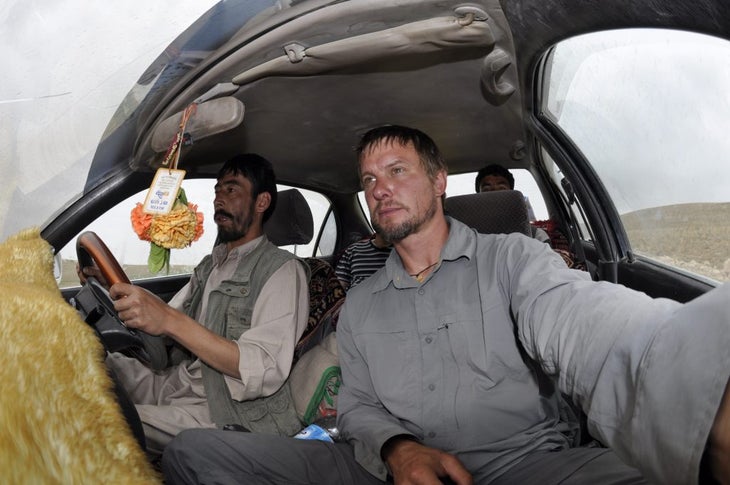
When he describes his expeditions, one thing that always comes up is the mathematical nature of risk. He plans and prepares intricately, he factors in the variables and the constants and he comes out with a final product. He doesn’t leave things up to chance. He knows his gear; he knows his systems; he knows the rock.
But that’s just the climbing side of things. For the first time in his life, there were considerable risk factors he couldn’t account for. Libecki was going to a place where many of the residents wouldn’t welcome an American, and he was going alone. How do you plan for that? How can you mitigate that risk? He made considerable effort, establishing secure communications with locals, chartering flights, and negotiating his way onboard with a military security company to serve as an escort part of the way there. At the end of the day, however, you can’t take away all the risk.
Into the Mountains
Libecki flew into Bamyan Province, west of Kabul, where Steve McCurry had taken the photo. Luckily, the military security company who took him on as a temporary “employee” also gave him access to their security insight and satellite phones. Aside from the photograph and some vague directions McCurry had given from memory , however, he had nothing to go off of. “Basically, we just took off in a 4×4 to go find these towers,” he said. He drove with a local guide and translator, tracking through the Koh-e-Baba, scanning for an image to match the photo.
It didn’t take long. After several hours on dirt roads, there they were, three rocky spires looming over the horizon. It was like he’d stepped into the picture.
He left the 4×4 behind and sat down with some local nomadic herders for a meal of tea, goat, and yogurt. The Afghans, he noted, took care of him like one of their own throughout his entire stay. Any concerns were unfounded. “It’s one of the best parts of any trip, to be able to connect with the local people,” he said, “and these were some of the kindest, most generous people I’ve ever encountered.” With the help of his translator, Libecki negotiated with these herders for a horse and mule, which he loaded with his gear. Thus equipped, he rode up into the shadow of the 15,000-foot towers and established a base camp.
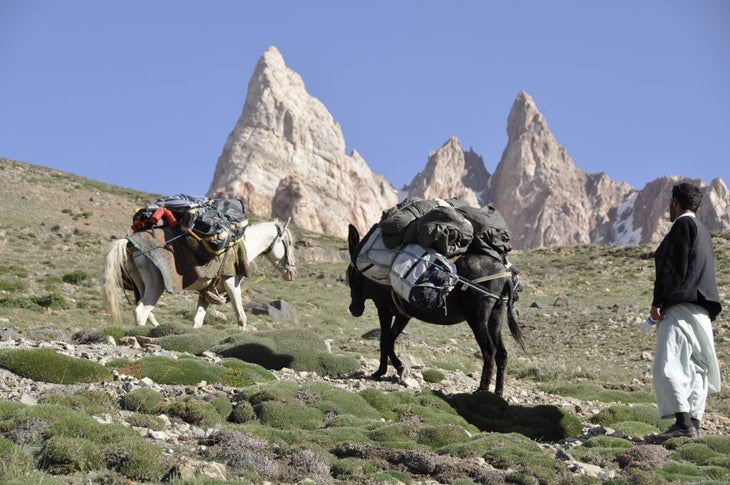
Not all was rosy, of course. Based on McCurry’s photograph “I thought the towers were going to be this pristine granite,” Libecki said. Upon closer inspection, he realized they actually consisted of loose, crumbling limestone. It wouldn’t be an easy summit. To make matters worse, a series of rain and snow storms kept him grounded for several days. He spent the time in his tent, planning, watching, and waiting for his chance.
When the weather system cleared, he started to climb.
It was smooth going at first, if chossy. “I’m aid soloing, setting up upward pulling anchors, pretty straightforward stuff,” he said, “but so much loose rock. I remember fixing a pitch, rapping down, and there’d be baseball size rocks hitting me the whole time. It was just a chossfest. Just shenanigans, you know?”
Four pitches up, however, he ran into more serious trouble. He was out 175 feet from his anchor, and the rock system he was following took him up to “an enormous, loose flake the size of a garage door, and almost a couple of feet thick.”
“It was just sort of stuck there,” said Libecki, “but I had no idea how it was hanging off the wall.” He began testing it with his hammer, playing with it. The crack he was in was solid and he didn’t want to leave it, but he could see no way up the wall without passing the flake. He was stumped. “I tapped it more with the hammer, then put in a cam,” he said. “Then I weighted it, and the cam immediately exploded out under some shitty rock.” Loath to mess with the formation again, he decided to traverse underneath it on hooks.
The decision to traverse the flake “still kind of fucks with me a little bit,” Libecki admitted, “because it really was a choice that I wouldn’t have normally made.” He managed to make it to the left side and began drilling a new anchor.
As he hit the bolt with his hammer to drive it in, however, he was deafened by a massive roar.
“That whole flake just completely fucking exploded,” he said. It catapulted down the face in a mass of shattering rock and mud. “It’s hard to try to even explain the power, the smell, of the heat and force of rockfall like that,” he added. “I was just fucking scared. I sort of curled up, I even peed my pants a little bit.”
Moments before, he had been underneath that flake. Miraculously, it didn’t pull his entire anchor off the wall. “I was sure it was going to drag me down,” he said. The rockfall had, however, cut his ropes in multiple places, slicing his lead line to the core and leaving his system in tatters. Libecki had come a hair’s breadth from death. For one of the first times in his career, he knew he’d made a serious miscalculation. In decades of wild ascents around the world, he’d never been rebuffed like this before. “I remember getting to the ground and just bawling. For no other reason than possibly failing my daughter.”
After repairing his systems, swapping his lead line and a fixed line, however, he decided to push on. Embrace the Joyage. Then, on the pitch above the flake, less than a hundred feet from the summit, a shatter of rockfall rained down, hitting his lead line again in two places. A grapefruit-sized rock smashed into his foot.
To continue would be lunacy, and he knew it. “It was like the wall was saying, ‘Did you not get the fucking message, dude?’” Libecki called a full retreat.
With a few days left before his scheduled return flight, he managed to tick the other two towers further east along the ridge, christened the East and West Ibex Ears (the primary formation was known as the “Ibex Horn”). The rock was loose, but the couloirs and ridgelines still mellow enough to allow for smooth, fast climbing.
“Same choss, same madness, I just found the easiest, safest way up,” he said.
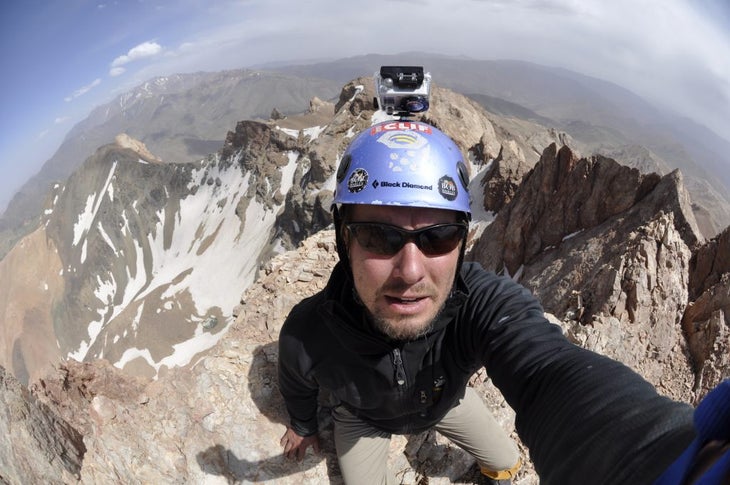
The Mathematics of Risk
Libecki arrived back in the USA safely, but he wasn’t able to let go of what had happened on the Koh-e-Baba. The image of the Ibex Horn loomed in his mind just as much as it had before he left. The experience had shaken him to his core.
In the past, climbing had always been mathematical. You know the strength of your systems, of your pro, your ropes, your slings. You know your fall factors and you track weather and you test rock quality … and you come out with an answer. Does it go, or does it not? It’s simple.
If you calculate this formula correctly, you’re safe, right?
The rockfall incident in the Koh-e-Baba turned Libecki’s system on its head. He’d experienced major rockfall before, of course, soloing in Queen Maud Land and other far-off locales, but it had never taken him by surprise like this. “It was just disappointing. I even went to therapy for this,” he said. “I mean, I almost was gone. It’s not like on a first ascent where you get rid of huge rock and you’re ready for it. It was a full on mistake.”
What would his daughter have thought if she’d heard her father had been killed in Afghanistan? What would she ask herself? Would she think, “Why? Why did my dad go over there and risk his life? Did I not matter enough to him?” This alternate reality tormented Libecki.
“The takeaway is that rockfall can kill you,” he said, matter-of-factly. “I’ve turned away from plenty of stuff over the years, which is why I say climbing is 100% mathematically safe. You just have to turn around. In that situation, I should’ve turned around. I knew the rock was sketchy, but I didn’t turn around.” He paused. “I got a little luck added to that variable in that equation, and I wasn’t killed. I was fortunate to get a wake-up call.”
Just as his narrow escape from the rockfall stuck in his mind, so too did the flora, the fauna, the harsh terrain, and nights by the campfire with Afghan nomads cooking goat and onion. Most of all, he couldn’t forget about those remote spires in the Koh-e-Baba.
Libecki knew he was going back. He was going after the first ascent of the Ibex Horn.
Return to the Koh-e-Baba
One year after the rockfall incident, Libecki was back in Afghanistan. In 2010, he’d attempted a couloir up the eastern side of the Horn. Now, he planned to come at the peak from the west side, hoping to find more solid rock.
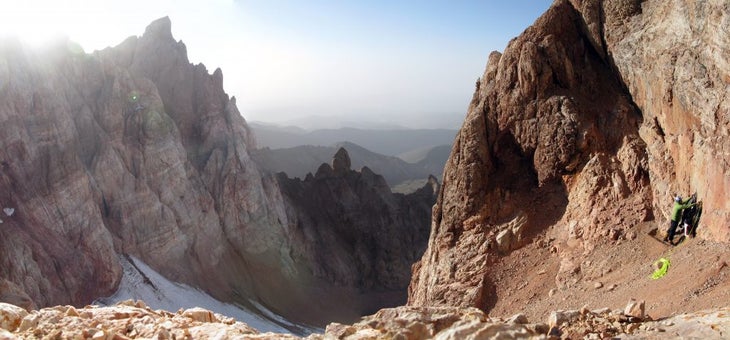
1,200 feet of steep climbing up a snow-covered couloir brought him to the base of the rock pitches. The following day, after a return to base camp, he rope-soloed two pitches up from his high point and bivvied. On the third day several more pitches, a couple traverses, and another couloir led him to the summit.
Nothing sketchy, no loose rock, no storms. x + y = z. The equation worked.
He arrived atop the Ibex Horn before dusk, ticking a 2,500′ line up the West and North Face (V 5.9 A1 WI2).
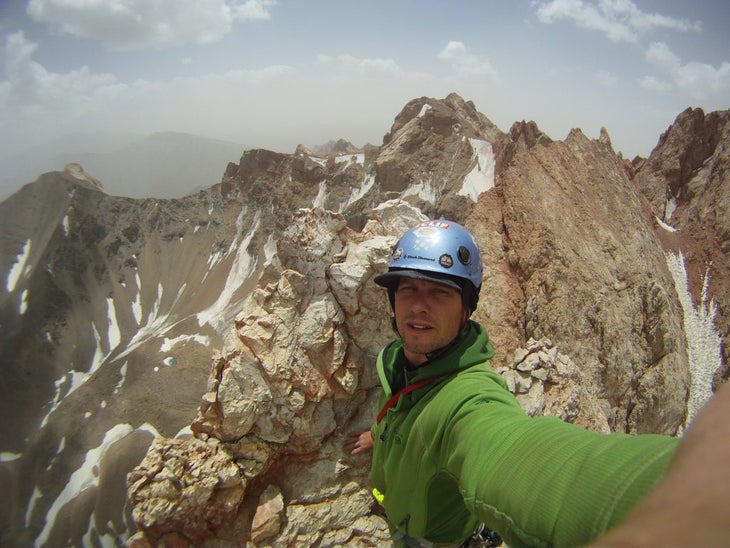
The Moment of Now
A few years back, Libecki had planned to return to Afghanistan yet again. He was driving his daughter to school one morning before the trip. She’d heard scary things about Afghanistan and was worried. He recalls,“She told me, ‘Dad, you have to pinky promise me you’re not going to go on this trip,’” He agreed. “She’s the only person I would do that for,” he said.
While Libecki would’ve been in Afghanistan, he and his daughter were driving to school again. NPR was on the radio reporting news of bombings in Afghanistan. The place Libecki had stayed during both prior trips—the place he planned to stay again—had been bombed. Most of those inside were killed. He could’ve been there. It was one more reminder of how thin the line he walked really was.
Libecki didn’t return to Afghanistan, (though he admits that he would now) but he did continue to travel the world, setting up dozens of remote lines in remote locales. He became National Geographic Explorer of the Year; he tackled climbs from Yemen to the South Pacific to Antarctica and back again. More than his sponsors or any financial or logistical support, however, “My daughter’s mom, Natalie, is the one I owe these trips to,” he says. “She’s the one who has made it possible for me to go on these expeditions. We split up when Lilli was three, but she supported the trips, the passion, made sure my daughter was happy and healthy when I was gone. I owe it all to her.”
***
While danger or risk may be a reason to turn back from an objective, like Libecki did in his first expedition to Afghanistan, in his mind, inherent risk is almost never a reason not to attempt the mission in the first place.
“You always go,” he said. “Always.”
When he says he suffers from “OECD: obsessive expedition climbing disorder” he’s only half-joking. When he talks about his life, it’s clear that two things matter to him: his daughter and his expeditions.
That’s not to say Libecki is obsessed with ticking off climbs. Like everything in his life, he describes his reasons for going on expeditions mathematically. “Climbing used to be 51% of the reason I went on these trips, but now it’s more like 49%,” he said. “51% of the reason is the people, the food, the experiences, the nature, everything else.”
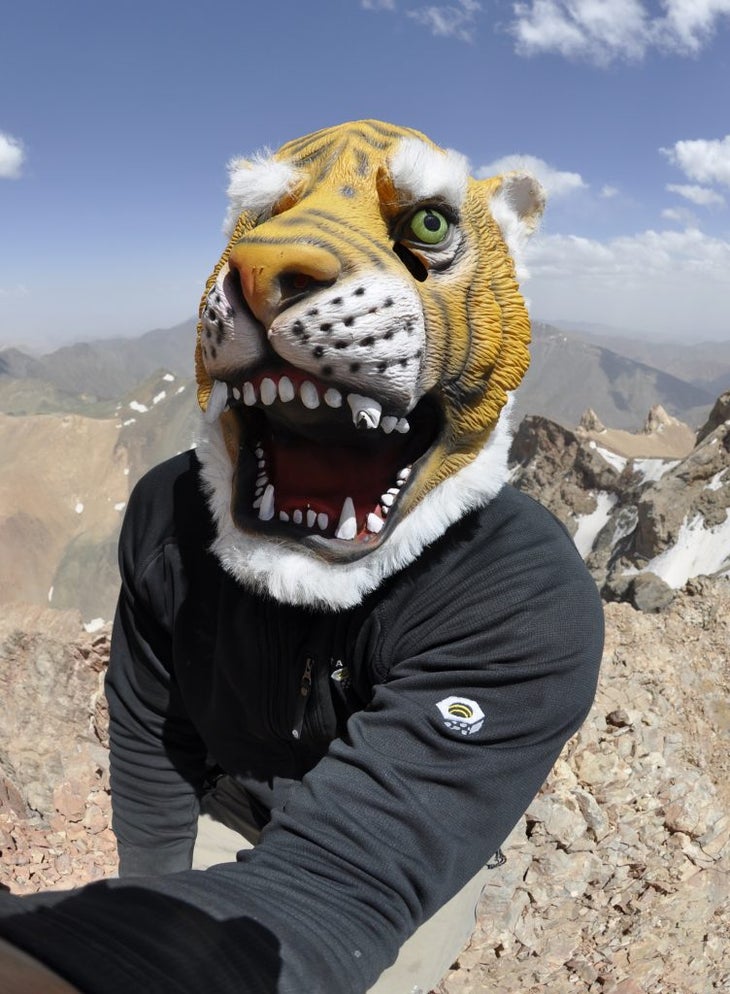
For him, it’s more than just that, even. He sees his expeditions as a form of meditation, a method of achieving a level of mindfulness not unlike that espoused in Buddhism. “It’s like, here I am for six weeks. I don’t have to think about the past or the future,” he said. On an expedition in the Koh-e-Baba, for example, there is no space for thoughts about politics or taxes or bills or the next episode of your favorite TV show. Furthermore, when you’re alone on expedition, like Libecki often is, there is no other person there to bring you back to the world. No partner or team member to remind you of the 21st century rat race that waits for you back home. It’s just you, enveloped in the present.
“I just have to think about the mission,” he said. “It’s about going into a deep moment of now, entering the present completely.”
“Finding that, it’s been the greatest discovery of my human life.”
The post After More Than 60 Expeditions, This is the Closest This Climber Has Come to Death appeared first on Climbing.

